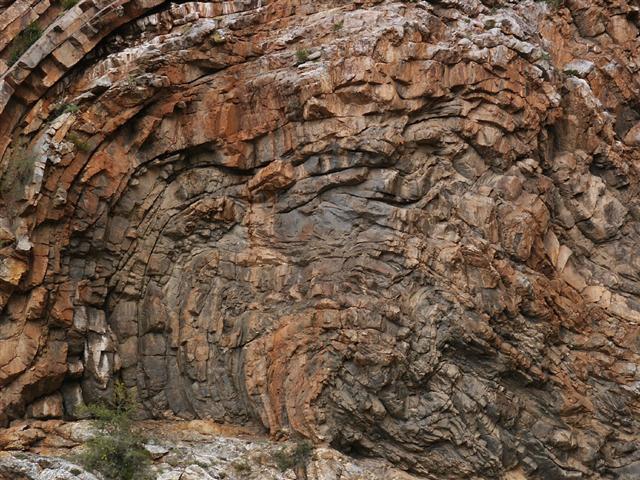Reader Question: How do geological layers work? #
This post is a response to a reader question.
Question #
Reader Matthew Garland asks:
Where do geological layers come from? If remains of civilizations and eras are buried, where did the material for the top layers come from? There can't be more material now than five thousand or million years ago.
Summary #
The answer to this reader question comes from Richard Lupia.
The formation of geological layers is a continuous process based on the settling of sediment and shifts in tectonic plates.

A geologic deli roll.
(Photo: Crinity at Flickr)
Explanation #
Geological layers, also called beds or strata, which contain buried civilizations are composed for the most part of fragments of rocks that form when bigger rocks are broken down by water, wind, or even organisms like plants. Once broken down, the fragments, called sediment, are transported by flowing water or blowing wind. Eventually, water stops flowing or wind stops blowing and the sediment settles, be it on the river bed or on the ocean bottom, or on floodplains alongside rivers when they flood. The fossil record is primarily a record of what lived in the oceans and in and along rivers.
Inasmuch as humans are dependent on water for sustenance, irrigation, etc., the bric-a-brac of human civilizations is ideally located to be buried by sediment when the rivers flood, which many do seasonally. It is worth noting that floods add new sediment that maintains the fertility of the floodplains for agriculture which also keeps humans near rivers.
The Earth does not run out of sediment because mountains constantly form and grow (slowly) as the plates—the 14 or so massively large blocks Earth's outer "shell" made of continents and ocean floor—shuffle around and collide. As mountains go up, there is always more rock to break down.
And although adding layer upon layer of sediment does indeed produce an increasingly thick pile of rock, it need not get higher and higher. There are two main reasons. First, as old sediment is buried by new sediment, water and air are squeezed out from the spaces between the sediment, and the old layer becomes thinner. For example, 10 feet of mud will on average yield a layer of rock about 1 foot thick. Second, the colliding of plates I mentioned above warps the ground over a very large area often bending it down to form a basin which lowers the Earth's surface.
Finally, I briefly add that sediment, and the oceanic part of the plates, are eventually recycled by sinking back into the deeper layers of the Earth. Where plates sink are called 'subduction zones' and are often apparent on maps as oceanic trenches (e.g., Mariana Trench, the deepest place on the surface of the Earth). The sinking of plates at subduction zones initiates the formation and growth of another type of mountain: volcanos. The ash and debris associated with volcanic eruptions blanket the surface and frequently bury human structures. The burial of Pompeii and Herculaneum by ash from the eruption of Mount Vesuvius in 79 CE is one famous example.
Richard Lupia is an Associate Professor in the School of Geology and Geophysics at the University of Oklahoma.
Explanation text licensed under
Creative Commons Attribution 3.0 Unported License.
Additional editing by The Metaist.